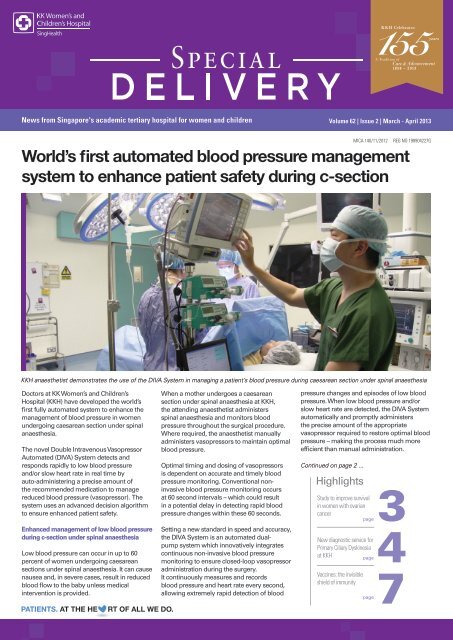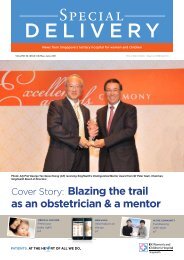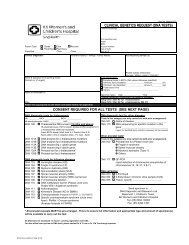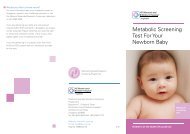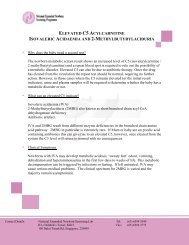View Issue - KK Women's and Children's Hospital
View Issue - KK Women's and Children's Hospital
View Issue - KK Women's and Children's Hospital
You also want an ePaper? Increase the reach of your titles
YUMPU automatically turns print PDFs into web optimized ePapers that Google loves.
MEDICALSPECIAL DELIVERY(continued…) World’s first automated blood pressure management system to enhance patientsafety during c-sectionStudy: DIVA System clinically effective inmanagement of blood pressureA preliminary study 1 jointly carried out by<strong>KK</strong>H <strong>and</strong> Duke-NUS Graduate MedicalSchool, Singapore (Duke-NUS) aimed toassess the performance <strong>and</strong> safety of theDIVA System in comparison to manuallyadministeredvasopressors usingconventional blood pressure monitoring.The study involved 55 healthy womenbetween the ages of 21 <strong>and</strong> 45, withsingleton full-term pregnanciesundergoing elective caesarean sectionunder spinal anaesthesia.Results showed that the DIVASystem is clinically moreeffective in maintaining bloodpressure during caesareansection under spinalanaesthesia, as it is able todetect <strong>and</strong> normalise bloodpressure fluctuations morequickly <strong>and</strong> effectively thantraditional physicianadministeredtechniquesusing conventional bloodpressure monitoring.Speed <strong>and</strong> accuracy deliver a safer <strong>and</strong>better birth experienceThe study was conducted among <strong>KK</strong>Hpatients from January to April in 2011. Theprincipal investigators were ProfessorAlex Sia, Chairman, Medical Board, <strong>KK</strong>H,<strong>and</strong> Dr Sng Ban Leong, Consultant,Department of Women’s Anaesthesia,<strong>KK</strong>H. They were assisted by Mr Paul TanHon Sen, a third-year medical student atDuke-NUS."The DIVA System holds much clinicalpotential for safer <strong>and</strong> more accuratecontrol <strong>and</strong> improvement of bloodpressure during surgery <strong>and</strong> critical caremanagement,” says Dr Sng.For Prof Sia, who is also Director of <strong>KK</strong>Research Centre, the technology is animportant safety enhancement forpatients. “We are constantly seeking outinnovation to help improve the quality ofcare we can provide to patients. The DIVASystem is a novel invention, enabling veryclose monitoring <strong>and</strong> rapid response tobetter manage patients’ blood pressureduring caesarean delivery. This newresearch development reinforces patientsafety <strong>and</strong> boosts clinical outcomes," saysProf Sia.|02“The automated system allows theanaesthetist to focus on other importantaspects of holistic patient care, includingestablishing better communication <strong>and</strong>rapport with patients <strong>and</strong> their partners.This further enhances the patient’s comfort<strong>and</strong> experience during a caesare<strong>and</strong>elivery,” adds Dr Sng.Caesarean sections are commonlyperformed under spinal anaesthesia, <strong>and</strong>patients remain awake during theprocedure.The study was approved by theSingHealth Centralised InstitutionalReview Board <strong>and</strong> funded by a NationalMedical Research Council ExploratoryDevelopment Grant.How the DIVA System worksThe DIVA System calculates the amount ofvasopressor to administer using acustomised algorithm based on integratedblood pressure data from a continuousnon-invasive arterial blood pressure(CNAP TM ) monitoring system. A closedloopfeedback system controlsvasopressor administration, ensuring thatthe patient receives only the precisedosage required (Figure 1).1. Two alternating finger cuffs measure thepatient’s arterial blood pressure <strong>and</strong>heart rate per second.2. The data is exported to a laptopcomputer, <strong>and</strong> integrated every fifteenseconds using a customisedprogramme to determine the dosage ofvasopressor required.3. If low blood pressure occurs,phenylephrine is administeredautomatically via a syringe pump. If lowblood pressure occurs in conjunctionwith slow heart rate, ephedrine isadministered instead via a differentsyringe pump.4. The vasopressor is administered over 15seconds, followed by a 30-secondlockout period to permit the vasopressorto take effect.Figure 1. Schematic diagram of the algorithm used in the DIVA System for infusion of phenylephrineor ephedrine.Systolic blood pressure within10% of baselineContinue CNAP TM monitoringReferences:CNAP TM Monitoring every secondData integrated every 15 secBenefits of the DIVA System:• Non-invasive, rapid <strong>and</strong> automaticdetection <strong>and</strong> response to low bloodpressure <strong>and</strong> slow heart rate• Delivers individualised optimalvasopressor dosing regimen• Maintains systolic blood pressure nearbaseline blood pressure*• Alleviates pre-delivery nausea <strong>and</strong>vomiting* Based on a prospective cohort study of 55healthy women, the system maintained arterialblood pressure at a mean (SD) of ‐9.1 (7.0)percent below baseline, with a 5.4 (2.5) percentfluctuation.Systolic blood pressure below10% of baselineHeart rate 60 or morebeats.min -1Infuse phenylephrine 50µgover 15 sec; lockout 30 sec1. Closed-loop double-vasopressor automated system to treat hypotension during spinal anaesthesia for caesareansection: a preliminary study’, Anaesthesia, 2012, 67, 1348-1355, dated December 2012Heart rate less than 60beats.min -1Infuse ephedrine 4mgover 15 sec; lockout 30 sec<strong>KK</strong> <strong>Women's</strong> <strong>and</strong> <strong>Children's</strong> <strong>Hospital</strong>
SPECIAL DELIVERYInternational study to improve survival in women withadvanced ovarian cancerNEWSClinical investigators at <strong>KK</strong> Women’s <strong>and</strong>Children’s <strong>Hospital</strong> (<strong>KK</strong>H) <strong>and</strong> researchersfrom Japan <strong>and</strong> Korea have launchedAsia’s first large-scale multi-centreinvestigation into an optimalintraperitoneal (IP) chemotherapy regimento treat advanced ovarian cancer.Ovarian cancer is the fifth most commoncancer affecting women in Singapore.More than 290 women are diagnosed withthe condition each year, of which 90percent suffer from epithelial ovarycancer, which arises from the lining of theovary.Due to its non-specificsymptoms, ovarian cancer isoften referred to as a “silentkiller”. It is commonlydiagnosed only at anadvanced stage, with lowerchances of treatment success.Two in three affected womeneventually lose their lives tothis disease.Improved treatment regimen for womenwith advanced ovarian cancerStarting in April 2013, the iPocc(IntraPeritoneal therapy for OvarianCancer with Carboplatin) clinical trialseeks to establish a new IntraPeritoneal(IP) chemotherapy regimen to improvepatient tolerability of this innovativetreatment method.IP chemotherapy involves the delivery ofanti-cancer drugs directly into theabdomino-pelvic cavity – the area whereovarian cancer most commonly spreads<strong>and</strong> recurs.The treatment method has been shown inlarge-scale clinical trials carried out in theUS to deliver an approximate 12-monthsurvival advantage for patients withadvanced epithelial ovary cancer, whoreceived IP chemotherapy after successfulsurgical removal of their cancerscompared with the st<strong>and</strong>ard way ofdelivering chemotherapy intravenously.However side effects include abdominalpain, nausea <strong>and</strong> vomiting caused by thetrial drug Cisplatin. As a result, less thanhalf the US trial participants managed tocomplete the prescribed six-cycletreatment. Due to the poor tolerability, thismethod of administering chemotherapyhas not been widely adopted for thetreatment of ovarian cancer.“Our goal is to establish animproved treatment regimen forepithelial ovary cancer, withreduced side effects to enhancepatient tolerance of IPchemotherapy.”- Dr Lim Sheow Lei, iPocc site principalinvestigator <strong>and</strong> Consultant, Department ofGynaecological Oncology, <strong>KK</strong>HTo that end, the iPocc clinical trial is beingconducted using Carboplatin, a cousindrug of Cisplatin, also known for itsequivalent efficacy <strong>and</strong> reduced risk ofside effects when given via theconventional intravenous route.“We hope this will enable more patients tocomplete the treatment cycle <strong>and</strong> benefitfrom the treatment’s significant survivaladvantage,” says Dr Lim.The iPocc trial is recruiting 120 Asianpatients mainly from Japan, Korea <strong>and</strong>Singapore, <strong>and</strong> plans to exp<strong>and</strong>recruitment to 700 patients in the laterphase. This is the first such major clinicaltrial to be conducted with Asian patients.Why use IP chemotherapy for ovariancancerOvarian cancer has a propensity of earlyspread <strong>and</strong> recurrence only in theabdomino-pelvic cavity for the vastmajority of patients.For most cancers, the st<strong>and</strong>ard way toadminister chemotherapy is via theintravenous route. However due to theunique pattern of spread <strong>and</strong> recurrenceof ovarian cancer, injecting chemotherapydirectly into the abdomino-pelvic cavityallows the drugs to come in direct contactwith the cancer tissues. This increasesexposure to the drug by a factor of up to10 times compared with that obtainedthrough intravenous administration.This method of treatment also allows thechemotherapy drugs to remain in thebody for a longer period of time,prolonging cancer exposure to the drugs.Risk factors for ovarian cancerA woman may be at increased risk forovarian cancer if she:• Has the defective BRCA1 or BRCA2gene. This gives her a 35-60 percentchance of developing ovarian cancer,<strong>and</strong> she is also at risk of developingbreast cancer. Hereditary ovariancancer accounts for 10 percent of allovarian cancer.• Is aged 40 or above• Has a body mass index (BMI) above 30• Has never given birth, or had her firstchild after age 30• Has never taken oral contraception• Had early menarche (before age 12)<strong>and</strong> late menopause (after age 50)• Has never breast fed• Uses estrogen-only hormonereplacement therapyWarning symptoms of ovarian cancerCommon• Abdominal bloating or distension• Abdominal or pelvic pain• Difficulty in eating or feeling full easily• Change in bowel habits – constipationor diarrhoea• Urinary symptoms – frequency ofurgencyLess common• Abnormal vaginal bleeding• Loss of appetite• Loss of energy• Weight loss• BreathlessnessTypically, six rounds of this treatment areadministered, over a four to five monthperiod.Ovarian cancer is potentially curable whendiagnosed early. Women should be awareof the warning symptoms of ovariancancer, <strong>and</strong> seek medical attention if anyof these symptoms persist for more thantwo weeks, or if they are recurrent.<strong>KK</strong> <strong>Women's</strong> <strong>and</strong> <strong>Children's</strong> <strong>Hospital</strong>|03
MEDICALSPECIAL DELIVERYNew diagnostic service for Primary Ciliary Dyskinesia at<strong>KK</strong>HDr Biju ThomasConsultant, Respiratory Medicine Service, Department of Paediatrics, <strong>KK</strong> Women’s <strong>and</strong> Children’s <strong>Hospital</strong>The Respiratory Medicine Service at<strong>KK</strong> Women’s <strong>and</strong> Children’s <strong>Hospital</strong> (<strong>KK</strong>H)has established Southeast Asia’s firststate-of-the-art laboratory for thediagnosis of Primary Ciliary Dyskinesia(PCD) – a somewhat under-recognisedgenetic disorder that may be the cause ofear, nose, sinus, respiratory <strong>and</strong> fertilityproblems in humans.The laboratory aims to provide PCDclinical diagnostic services for both adults<strong>and</strong> children, as well as establish data onthe incidence <strong>and</strong> prevalence of thiscondition in Singapore. Such data hasthus far been lacking due to the nonavailabilityof facilities <strong>and</strong> expertise toaccurately diagnose this condition. Thelaboratory facilities would also supportresearch activities of the RespiratoryMedicine Service at <strong>KK</strong>H.What is Primary Ciliary Dyskinesia?The human respiratory tract, whichincludes the nose, sinuses <strong>and</strong> thebreathing tubes in the lungs, is lined byepithelium that has tiny hair likeprojections, known as cilia (Figure 1).Motile cilia are also found in other parts ofthe body such as the fallopian tubes inwomen, sperm in men <strong>and</strong> the brain. Theyperform important functions in the body’ssystems.Such complications may include chronicEar Nose <strong>and</strong> Throat (ENT) problems<strong>and</strong> respiratory complications such asbronchiectasis – often leading to poor lungfunction, poor effort tolerance <strong>and</strong>frequent exacerbations of respiratorysymptoms requiring medical care, <strong>and</strong>hence a poor quality of life.High prevalence of PCD in the British-Asian populationPCD has an estimated prevalence of 1 in15,000 to 1 in 30,000 live births in theCaucasian population, though this ishighly likely to be an underestimate. Datafrom the United Kingdom suggests that itsincidence may be much higher – anestimated 1 in 2,265 – in the British-Asianpopulation.There is presently no data available on theincidence <strong>and</strong> prevalence of PCD inSingapore <strong>and</strong> Southeast Asia. The PCDdiagnostic laboratory at <strong>KK</strong>H aims toprovide diagnostic services to adults <strong>and</strong>children in Singapore <strong>and</strong> theneighbouring countries in the region,develop diagnostic <strong>and</strong> managementprotocols for PCD, gather data on theprevalence of PCD in the region <strong>and</strong>promote research on this condition.Major clinical effects associated with PCDa structurally abnormal <strong>and</strong>/or improperlypositioned heart, liver, intestines <strong>and</strong>/or spleen.These abnormalities arise early in embryonicdevelopment.FertilityCilia are present in the fallopian tubes inwomen. The ultrastructure of the human spermtail also closely resembles that of cilia. As ciliaplay important roles in maintaining normalfertility, PCD can result in infertility in men, <strong>and</strong>subfertility in women. Most men with PCDexperience reduced sperm motility. Their spermare still viable, but because the sperm tails donot function properly, the sperm is unable tomove successfully towards the egg.Women with PCD are at increased risk ofmiscarriage or ectopic pregnancies – acondition in which the embryo implantsoutside the uterus, such as in a fallopian tube.However some women with PCD are able toconceive normally.How is PCD diagnosed?At the <strong>KK</strong>H PCD Laboratory, diagnostictesting for PCD in children includes threesteps.1. Clinical assessmentComprehensive clinical assessment ofthe patient is done as the first step.For instance, cilia keep the airways clearof mucus, germs <strong>and</strong> inhaled particlesthrough a process known as mucociliaryclearance. PCD is an inherited (commonlyas autosomal recessive) disorder of theultrastructure of the cilia, that impairs itsnormal function.Figure 1. Scanning electron microscopy imageof the ciliated epithelium of the human noseAbnormalities of ciliary function can resultin increased vulnerability to infection <strong>and</strong>inflammation in the lungs, ears <strong>and</strong>sinuses; abnormalities in organ placement<strong>and</strong>/or development <strong>and</strong> infertility. As aresult, delayed diagnosis <strong>and</strong> inadequatetreatment of PCD often result in severe<strong>and</strong> irreversible complications.The clinical manifestations of PCD inaffected patients can be variable.However, problems with respiratoryhealth, fertility <strong>and</strong> organ positioning arecommon.Respiratory HealthIn a person with PCD, abnormalities of ciliaryfunction in the airways result in impairedmucociliary clearance. Loss of ciliary activitycauses the nose, ears, sinuses <strong>and</strong> lungs tobe more vulnerable to bacterial colonisation,infection <strong>and</strong> inflammation.Infection at these sites is usually recurrent orchronic, often leading to complications suchas chronic Rhinitis, Sinusitis, Otitis Media <strong>and</strong>Bronchiectasis. Approximately 50 percentof children with PCD experience significanthearing problems as a complication ofrepeated ear infections.Organ Positioning/DevelopmentAbout 40 percent of people with PCD have amirror-image reversal of their internal organs(Situs Inversus Totalis). A small proportionof people with PCD have a condition knownas Heterotaxy, which is characterised by2. Measurement of nasal nitric oxide as ascreening testThe patient’s nasal nitric oxide (NO)level is then measured in the lungfunction laboratory. Patients with PCDcommonly have markedly reducedlevels of nasal nitric oxide.3. Analysis of ciliary function <strong>and</strong>ultrastructureA sample of the patient’s respiratoryepithelium is obtained by brushing theinside of the nose using a soft cytologybrush.The respiratory epithelium sample isthen analysed for ciliary function usingthe high-speed digital video microscopysystem at the <strong>KK</strong>H PCD Laboratory,before being sent to the Institute ofMolecular <strong>and</strong> Cell Biology (A*STAR),Singapore, for assessment of ciliaryultrastructure, using transmissionelectron microscopy.PCD can be caused by a number ofgenetic defects in the ciliaryultrastructure (Figure 2), each of whichmay result in ineffective ciliarymovement.|04<strong>KK</strong> <strong>Women's</strong> <strong>and</strong> <strong>Children's</strong> <strong>Hospital</strong>
SPECIAL DELIVERYTable 1. Clinical Presentation of Primary Ciliary DyskinesiaWhen should PCD be considered in apatient?By system affectedENTBy age of presentationFamily historyIn a typical case of PCD, symptomsfrequently start in the newborn period<strong>and</strong> may include a chronic nasaldischarge <strong>and</strong> cough. The newborn mayalso experience respiratory distress orrapid breathing requiring oxygen insome instances.Among young children with PCD, achronic wet (productive/phlegmy) coughis common, as are recurrent earinfections, inflammation of the middleear with effusion (glue ear) <strong>and</strong>persistent ear discharge followinggrommet insertion. Recurrent earinfections often result in some degree ofhearing impairment.Symptoms may also mimic Asthma, butwould typically be unresponsive orpoorly responsive to st<strong>and</strong>ard Asthmamanagement. If diagnosis is delayed,the child may present with establishedbronchiectasis, reduced lung function<strong>and</strong> poor effort tolerance.PCD may also be associated withabnormalities of other body systems.The clinical presentations that may formindications for referral to the PCDdiagnostic service are listed in (Table 1).PCD should be considered in thedifferential diagnosis of such children<strong>and</strong> a referral for further assessmentmay be warranted.Neonatal persistent RhinorrhoeaChronic nasal congestionMucopurulent RhinitisNasal PolyposisChronic SinusitisRecurrent/Chronic Otitis MediaPersistent ear discharge following grommetinsertionConductive hearing lossRespiratoryNeonatal respiratory distress of no obviouscauseChronic wet (productive) coughRecurrent chest infectionsBronchiectasisAtypical Asthma unresponsive to therapyGenitourinary tractMale <strong>and</strong> female infertility problemsEctopic pregnancyOther associations (CVS, CNS, GI systems)Situs Inversus TotalisHeterotaxyComplex congenital heart diseaseDextrocardiaHydrocephalusCerebral Ventriculomegaly with no obviouscauseOesophageal Atresia <strong>and</strong> other severedefects in oesophageal functionBiliary AtresiaConsanguinityClose relatives with confirmed orsuspected PCDAntenatalHeterotaxy on prenatal ultrasoundNewborn periodPersistent RhinorrhoeaNeonatal respiratory distress of noobvious causeTransient tachypnoea of newbornChildhoodChronic productive coughAtypical Asthma unresponsive to therapyIdiopathic BronchiectasisChronic RhinosinusitisRecurrent Otitis Media with effusionPersistent ear discharge followinggrommet insertionAdolescence <strong>and</strong> adult lifeSame as for childhood.In addition:Subfertility <strong>and</strong> ectopic pregnancy inwomenInfertility in men with immotile spermSputum colonisation with pseudomonas,other gram negative bacteria or nontuberculousmycobacteriaNormal ciliumAbnormal ciliumFigure 2. Transmission electron microscopyimage showing cross section of a normal cilium(left) <strong>and</strong> an abnormal cilium (right) with absentinner <strong>and</strong> outer dynein arms.Treatment options for PCDWhile PCD has no known cure as yet, thest<strong>and</strong>ards of procedures for diagnosis <strong>and</strong>management have been well established.Patients with PCD will require individualisedmanagement programmes, depending on theage of presentation <strong>and</strong> the nature <strong>and</strong>severity of their clinical problems.Management of respiratory problems causedby PCD involves close monitoring forintercurrent chest infections, regular sputumcultures to identify infective organisms, chestphysiotherapy to aid sputum clearance <strong>and</strong>appropriate antimicrobial agents or othermedications. ENT problems commonly arise,requiring close monitoring <strong>and</strong> managementby ENT surgeons. Adult patients with fertilityproblems are best managed in a centre withspecialised infertility services.With early diagnosis <strong>and</strong> appropriatemanagement, complications can beprevented; patients can maintain lung function<strong>and</strong> enjoy a good quality of life. Patientssuspected of having PCD should be referredfor diagnostic assessment.GP CONTACTTo make a physician referral or for moreinformation about PCD, please contact theRespiratory Medicine Service, <strong>KK</strong>H at+65 6225 5554.References:1. Barbato A. et al. Eur Respir J. 2009; 34(6): 1264-762. Pasteur MC et al. Thorax 2010; 65: i1-i583. Bush A, Chodhari R, Collins N, et al. Primary ciliary dyskinesia: current state of the art. Arch Dis Child2007; 92:1136–40.4. O'Callaghan C, Chetcuti P, Moya E. Arch Dis Child. 2010 Jan; 95(1):51-2.Dr Biju Thomas was trained in India, Australia <strong>and</strong>the UK. He obtained Fellowship of Royal College ofPaediatrics & Child Health (FRCPCH) in 2010 <strong>and</strong>completed advanced specialty training in paediatricrespiratory medicine, (CCT, UK). He recently obtaineda degree in research (MD) from the University ofLeicester, United Kingdom. Within the field of paediatricrespiratory medicine, his main areas of interest includeAsthma, Bronchiectasis, Primary Ciliary Dyskinesia,sleep medicine <strong>and</strong> bronchoscopy.<strong>KK</strong> <strong>Women's</strong> <strong>and</strong> <strong>Children's</strong> <strong>Hospital</strong>|05
MEDICALSPECIAL DELIVERYSilent killers uncovered – Inborn Errors of MetabolismDr Tan Ee ShienDirector, National Exp<strong>and</strong>ed Newborn Screening ProgrammeConsultant, Genetics Service, Department of Paediatrics, <strong>KK</strong> <strong>Women's</strong> <strong>and</strong> <strong>Children's</strong> <strong>Hospital</strong>Inborn Errors of Metabolism(IEM) affect 1 in 3,000 births inSingapore <strong>and</strong> worldwide.Many can be treated; howeverdelayed diagnosis <strong>and</strong>treatment can lead toirreversible negative effects onthe child.What are Inborn Errors of Metabolism?Inborn Errors of Metabolism (IEM) are avariety of genetic disorders that causechildren to be unable to process nutrientssuch as fats or proteins from their diet.IEM can present in many ways. Some ofthe common ways of presentation includeliver or heart disease, Metabolic Acidosis,low blood sugar <strong>and</strong> seizures.When should doctors suspect an IEMcondition?Doctors should be suspicious where afamily’s history reveals previousundiagnosed baby deaths or unexplainedsevere childhood illnesses in which nosatisfactory diagnosis was reached.Maternal complications during pregnancycan also be a clue – In the case of a foetuswith Fatty Acid Oxidation Disorders(FAOD), the pregnant mother ispredisposed to developing acute fatty liverof pregnancy (AFLP), excessivebreakdown of red blood cells, elevatedliver enzymes <strong>and</strong> low platelet count, alsoreferred to as HELLP syndrome.Diagnosis also enables doctors to providegenetic counselling to first-time parents,<strong>and</strong> help them plan for subsequentpregnancies.Benefits of screening for IEMThe metabolic screening test is universallyavailable at every birthing hospital inSingapore. A few drops of blood from apinprick of the newborn’s heel are all ittakes. The test is optional, but here arethree reasons why parents should notopt out.1. Babies with IEM disorders often appearhealthy at birthIEM disorders are often undetectableuntil symptoms appear. The childusually appears healthy at birth, butbecomes ill after some time.2. No family history of IEM disorders isnot a guarantee that the baby will nothave itIEMs are hereditary; therefore havingblood relatives with a particular IEMincreases the risk of a child having thesame disorder. However in most casesof IEM conditions, there is no clearfamily history, <strong>and</strong> the best way to besure is to undergo screening.3. Serious health problems can beprevented through early detection <strong>and</strong>treatmentIEM disorders most commonly presentin babies within their first month of life.Early screening enables doctors todetect <strong>and</strong> treat a number of thesedisorders before the onset ofsymptoms, <strong>and</strong> is crucial for optimalpatient outcomes.National Newborn Screening for IEMconditionsThe National Exp<strong>and</strong>ed NewbornScreening Programme was established by<strong>KK</strong> Women’s <strong>and</strong> Children’s <strong>Hospital</strong> (<strong>KK</strong>H)in 2006. The biochemical geneticslaboratory at <strong>KK</strong>H receives blood samplesfrom hospitals nationwide, <strong>and</strong> screensnewborn babies for over 30 IEMconditions.To date, the programme has identified awide range of IEM, some of which wereearlier not known to occur in Singapore.Two IEM conditions which commonlyoccur in Singapore are MethylmalonicAciduria (MMA) <strong>and</strong> Fatty Acid OxidationDisorders (FAOD).Information for ParentsBabies delivered at <strong>KK</strong>H or SingaporeGeneral <strong>Hospital</strong> (SGH) will be screened.Parents may choose to opt out of themetabolic screening test for their child,but should seek medical advice beforedoing so. For hospitals other than <strong>KK</strong>H orSGH, parents should speak to theirhealthcare provider, to request for the test.For more information about the metabolicscreening test in Singapore, please speakto your healthcare provider, or contact theNational Exp<strong>and</strong>ed Newborn ScreeningLaboratory at metabolic.screening.laboratory@kkh.com.sg or +65 6394 5049.IEM Profile: Methylmalonic Aciduria(MMA)• Patients with MMA have difficultymetabolising protein, which results inexcess acid in the body fluids.• Symptoms resembling neonatal bloodinfection typically appear by day 3-4 oflife. These include breathing problems,vomiting <strong>and</strong> poor feeding.• Management includes a low proteindiet <strong>and</strong> carnitine supplements.IEM Profile: Fatty Acid OxidationDisorders (FAOD)• Patients with FAODs have difficultymetabolising fats, which are animportant source of energy for thebody.• Symptoms include low blood sugar,heart muscle disease or muscle disease<strong>and</strong> can appear at any time from thefirst month of life to adulthood.• Management includes avoidance offasting <strong>and</strong> administration ofintravenous dextrose.Dr Tan Ee Shien started practice as a generalpaediatrician in 2002 <strong>and</strong> subsequentlytrained in the area of clinical genetics <strong>and</strong>genetic metabolic disease. She is an AssistantProfessor at Duke-NUS Graduate MedicalSchool <strong>and</strong> Yong Loo Lin School of Medicine.Dr Tan was awarded the SingHealth ClinicianScientist Award in 2008. Her current interestsinclude the clinical management of InbornErrors of Metabolism <strong>and</strong> newborn screening.|06<strong>KK</strong> <strong>Women's</strong> <strong>and</strong> <strong>Children's</strong> <strong>Hospital</strong>
SPECIAL DELIVERYMEDICALVaccines: The invisible shield of immunityDr Thoon Koh ChengHead <strong>and</strong> Consultant, Infectious Disease Service, Department of Paediatrics, <strong>KK</strong> Women’s <strong>and</strong> Children’s <strong>Hospital</strong>This World Immunisation Week (24-30 April2013) we mark one of the greatest publichealth achievements in Singapore – theroutine childhood vaccination.The use of vaccines to protect, or“immunise”, people of all ages againstdisease is one of the world’s mostsuccessful <strong>and</strong> cost-effective healthinterventions, preventing debilitatingillness, disability <strong>and</strong> death. Internationalhealth authorities have found thatvaccines have probably saved more lives<strong>and</strong> life-years than all other medicalinterventions in history combined.In Singapore, the National ChildhoodImmunisation Programme (NCIP) wasintroduced in 1962, <strong>and</strong> has since virtuallyeliminated the incidence of Diphtheria,neonatal Tetanus, Poliomyelitis <strong>and</strong>congenital Rubella in children. In thisway, vaccines help every child from everylevel of society get an equal opportunityto reach their full potential <strong>and</strong> contributeto society – provided every child receivestheir full suite of vaccinations.What are vaccines <strong>and</strong> how do theyprovide immunity?A vaccine is a preparation of a weakenedor killed infectious agent, or parts of theinfectious agent, such as a bacterium orvirus. Upon administration, the vaccineinduces a controlled or modified infection,stimulating the body to produce animmune response against the infectiousagent, but is usually incapable of causingsevere infection. This “active” type ofimmunisation results in subsequentimmunity in most people, so that theperson does not develop the disease lateron, <strong>and</strong> confers long-lasting or even lifelongprotection from the disease.The benefits of vaccinationVaccines provide the best opportunitiesfor parents to protect their children againstvarious infectious agents, rather thanhaving to treat or manage these infectionswhen they occur – a preventive rather thancurative approach. Beyond protecting theindividual, another key role of vaccinesis to prevent further transmission ofinfection <strong>and</strong> provide indirect protection tothe community, or “herd immunity”.Example of herd immunity:Mr <strong>and</strong> Mrs Tan live together with MrsTan’s parents <strong>and</strong> their son. Both Mr <strong>and</strong>Mrs Tan are vaccinated against infectiousdisease ‘A’, while Mrs Tan’s parents <strong>and</strong>son cannot be vaccinated (due to severalreasons such as allergies or being oncertain medications).When Mr <strong>and</strong> Mrs Tan come into contactwith infectious disease ‘A’, because theyhave been vaccinated, they do not developthe disease, <strong>and</strong> cannot transmit theinfection.But if only a few people in the communitythe Tans live in are vaccinated againstinfectious disease ‘A’, there is a highprobability that Mrs Tan’s parents or childmay come into contact with the diseasewhen they are outdoors, <strong>and</strong> becomeinfected. However, if enough people in thecommunity are also vaccinated againstinfectious disease ‘A’, the vaccinatedpopulation forms an invisible “shield”around the Tan family, such that nonvaccinatedindividuals are no longer“able” to transmit infection to thevulnerable family members.The role of the primary care physician inprotecting the communityWhile primary care physicians <strong>and</strong>paediatricians are the first line ofhealthcare providers to deliver vaccines,parents also need to be willing to allowtheir children to be vaccinated. Childrenwho are not vaccinated, or have notreceived the full suite of vaccinations, areat increased risk of acquiring infection <strong>and</strong>subsequently disease, <strong>and</strong> spreading it on.Primary healthcare providers shouldalways view immunisation records ifpossible, <strong>and</strong> encourage parents tovaccinate their children against all vaccinepreventablediseases as per the NCIPrecommended schedule. Mild illnessesshould not prevent the child from receivingvaccines, nor should allergies in the familybut not known to be present in the childbe a deterrent. If in doubt, parents shouldseek advice from their healthcare provider.Unimmunised children <strong>and</strong> adults notcovered by the NCIP remain highlysusceptible to vaccine-preventablediseases, <strong>and</strong> should be strongly advisedto obtain appropriate vaccinations tocatch-up, especially before travelling tocountries which are endemic for thesediseases or where outbreaks are occurring.Advances in vaccines <strong>and</strong> immunologyAs an advocate for childhoodimmunisation in Singapore, <strong>KK</strong> Women’s<strong>and</strong> Children’s <strong>Hospital</strong> (<strong>KK</strong>H) continuesto work towards improving nationalimmunisation practices through researchtrials for existing <strong>and</strong> investigationalvaccines for diseases such as CervicalCancer, Pneumococcal Invasive Diseases,Rotavirus <strong>and</strong> Dengue. The hospital alsorecently created a vaccine pocketbook toguide healthcare providers in Singapore.<strong>KK</strong>H is currently the first <strong>and</strong> only sentinelsite in Singapore for active surveillanceto detect vaccine adverse events inwomen <strong>and</strong> children. HK InSpire - theHSA-<strong>KK</strong>H Inpatient Surveillance of PostImmunisation Reactions Programme is apartnership with Health Science Authority,Singapore, that monitors vaccines tomaximise the safety of childhood <strong>and</strong>women's obstetric vaccines in Singapore.Vaccines have the power to immunisefuture generations against vaccinepreventablediseases <strong>and</strong> even potentiallyeradicating diseases permanently. It isonly through a unified effort that we willbe able to continually evolve new <strong>and</strong>improved vaccines <strong>and</strong> immunisationpractices to protect public health inSingapore <strong>and</strong> the region.GP CONTACTIf you are a primary healthcarephysician, you can help to improveSingapore's vaccine safety surveillanceby reporting potential vaccine adverseevents <strong>and</strong> collaborating in vaccinerelatedresearch. For more information,please contact the Infectious DiseaseService, <strong>KK</strong>H at +65 6225 5554.Dr Thoon Koh Cheng heads the Infectious DiseaseService at <strong>KK</strong> Women’s <strong>and</strong> Children’s <strong>Hospital</strong>, <strong>and</strong>is an Adjunct Assistant Professor at the Duke-NUSGraduate Medical School <strong>and</strong> Yong Loo Lin Schoolof Medicine. Dr Thoon’s main research interestsare in mycobacterial infections (Tuberculosis<strong>and</strong> nontuberculous Mycobacteria), vaccinepreventable diseases, severe invasive bacterial <strong>and</strong>viral diseases, HIV <strong>and</strong> Dengue. He is currently amember of Ministry of Health’s Expert Committeeon Immunisation <strong>and</strong> the National AntimicrobialTaskforce.<strong>KK</strong> <strong>Women's</strong> <strong>and</strong> <strong>Children's</strong> <strong>Hospital</strong>|07
SPECIAL DELIVERYVOLUME 62 | ISSUE 01 | MAR - APR' 13MAILBAGWe are writing to express our sincere compliments <strong>and</strong> profoundgratitude to the staff at <strong>KK</strong>H's Children Intensive Care Unit (CICU)for everything they did for our son Kai En. From the doctors tothe nurses <strong>and</strong> healthcare assistants, our son could not havereceived better care <strong>and</strong> medical service during his stay in CICU.Kai En spent approximately two weeks in the CICU <strong>and</strong> Stepdownunit, <strong>and</strong> was extremely well looked after by the staff ofCICU. Although his condition was heartbreaking at the time,the CICU staff clearly made his well-being a priority, which washighly reassuring.The doctors were very dedicated <strong>and</strong> competent. They treated uswith great respect <strong>and</strong> consideration, keeping us informed <strong>and</strong>updated. Thanks to their clear explanations, my wife <strong>and</strong> I knewwhat was being done for our son, <strong>and</strong> why.The nursing staff were also truly wonderful, going out oftheir way to be kind <strong>and</strong> put my wife <strong>and</strong> me at ease. Withoutexception, they treated our son with tender care <strong>and</strong> gave us kindsupport. Help <strong>and</strong> advice were there whenever we needed themfor our son. This helped to keep our spirits up throughout thelong haul.Kai En owes it all to the expertise <strong>and</strong> dedication of everybodywho works in the CICU. Our greatest thanks to the CICU teamfor the wonderful care <strong>and</strong> concern you showed Kai En <strong>and</strong> ourfamily. God bless you all.Yours Sincerely,Tay Thiam Siew & Lin Ching Hsien(Parents of Tay Kai En)HEALTHCARE FORUMSContact information:<strong>KK</strong> Women’s <strong>and</strong> Children’s <strong>Hospital</strong>100 Bukit Timah RoadSingapore 229899Tel: 6-CALL <strong>KK</strong>H (6-2255 554)Fax: 6293 7933Website: www.kkh.com.sgEmail: corporate.communications@kkh.com.sgWe are on facebook. 'Like' us for updates <strong>and</strong>news about <strong>KK</strong>H.www.facebook.com/<strong>KK</strong>H.sgMedical Editorial Committee:Associate Professor Anne GohHead <strong>and</strong> Senior Consultant,Department of Paediatrics, Allergy Service,<strong>KK</strong> Women’s <strong>and</strong> Children’s <strong>Hospital</strong>Adjunct Associate Professor,Duke-NUS Graduate Medical SchoolDr Nancy TeeHead <strong>and</strong> Senior Consultant,Department of Pathology <strong>and</strong> LaboratoryMedicine,<strong>KK</strong> Women’s <strong>and</strong> Children’s <strong>Hospital</strong>Adjunct Associate Professor,Duke-NUS Graduate Medical SchoolDr Serene LimSenior Consultant, Department of PaediatricAnaesthesia,Senior Consultant, Children’s Pain Service,<strong>KK</strong> Women’s <strong>and</strong> Children’s <strong>Hospital</strong>Dr Tan Thiam ChyeConsultant,Department of Obstetrics <strong>and</strong> Gynaecology,Deputy Campus Director, Education Office,<strong>KK</strong> Women’s <strong>and</strong> Children’s <strong>Hospital</strong>Assistant Professor, Duke-NUS GraduateMedical School & NUS Yong Loo Lin Schoolof Medicine<strong>KK</strong> <strong>Women's</strong> <strong>and</strong> <strong>Children's</strong> <strong>Hospital</strong>|08


